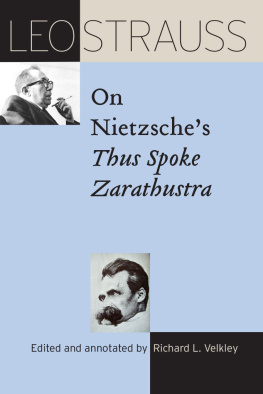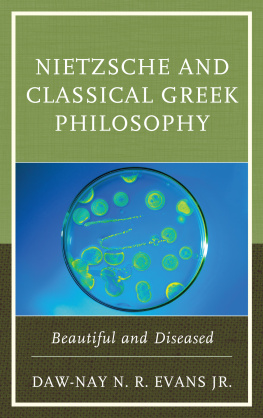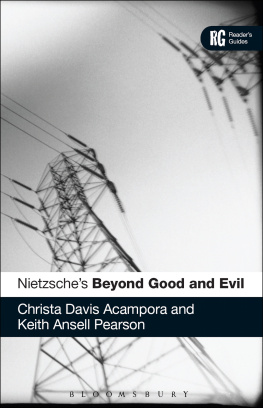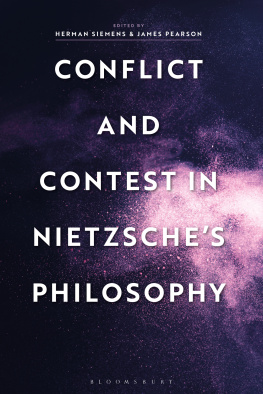Acknowledgments
This project had a number of estimable forefathers, not the least of whom is Graham Parkes. In his Composing the Soul: Reaches of Nietzsches Psychology (Chicago, 1994), Parkes writes, We can now inquire into the ecology of the soul understood as the logos of its oikos, the way it speaks of its household and the denizens thereof, of its inner menage and menagerie. Specifically, what kinds of relations obtain between animal forces contained within the household and those that are in the wild, undomesticable? And under what organization of the passions of the soul, imagined as potentially domesticable energies, would we flourish best? The richest field for this inquiry is Thus Spoke Zarathustra, which contains an abundance of faunae unmatched in any other work of Western philosophy. Not since Aristotles magnificent treatises on animals has such a vast and varied bestiary crawled, soared, swum, trotted, and slithered through the pages of a philosophical text. Over seventy different species are mentioned by name, ranging from domestic animals to wild beasts, from fishes to birds, insects to reptiles (p. 215). Although this project was already underway prior to the publication of Parkes book, it nevertheless is greatly indebted to the work and its author. We are specifically grateful to Parkes for advice and support, for his taking time to read and comment upon papers even though his schedule did not permit him to contribute an essay.
The work on the index of animal references in Nietzsches works would not have proceeded as smoothly as it did were it not for the helpful suggestions and advice supplied by the group of editors for the Nietzsche Dictionary project, particularly Paul van Tongeren, Herman Siemens, Gerd Schank, and Alexander-Maria Zibis. Brian Crowley deserves special recognition for the assistance he provided numerous contributors as he shared with them drafts of his entries for the index. He has a fine and promising philosophy career ahead of him. For his assistance with the general index, we thank Robert Spinelli.
Earl Nitschke selected the images incorporated in the cover design and created several of the illustrations in the body. We are most thankful for his contributions to what we think is a rather handsome book.
Audiences at the meetings of the International Association for Philosophy and Literature (Stony Brook, 2000) and the Society for Phenomenology and Existential Philosophy (Penn State, 2000) heard several of the papers presented in early drafts. We are grateful for their stimulating discussion and supportive enthusiasm, both of which buoyed the project. We are also grateful for comments we received from anonymous reviewers. One reviewer in particular offered especially helpful encouragement that we reconsider the organization of the volume. We think our efforts to take up that suggestion resulted in a book that is better than it might have been otherwise.
Hunter College provided financial assistance in the form of two grants, including a Hunter Grant for Teaching and Excellence in Research and the Eugene Lang Student-Faculty Award, which supported the acquisition of research materials and travel to Nijmegen. Christa also benefited from release time made possible by a grant awarded by the Research Foundation of the Professional Staff Congress of the City University of New York.
Finally, a word of gratitude to acquisitions editor Eve DeVaro, editorial assistants John Wehmueller and Tessa Fallon, and editor-in-chief Jon Sisk for acquiring the project. As university presses are slashing lists and discontinuing acquisitions in many areas, there has never been a more urgent need for quality independent academic publishers. We are most grateful for the association.
AFTERWORD
Paws, Claws, Jaws, and Such: Interpretation and Metaphoric Modalities
Christa Davis Acampora
Nietzsches bestiary includes not only whole animate forms but also hundreds of references to different animal parts. Unlike Aristotles interest in the parts of animals, Nietzsches concern is not, of course, to ascertain their function in a fixed form but rather to discover and recover the variety of resourcesdomesticated, wild, and feralupon which humans draw (or to which they resort), particularly in the context of interacting with other human beings. I wish to focus on some ontological aspects of Nietzsches use of animal parts as they have a bearing on the possibilities of human existence. In so doing, I shall make observations about Nietzsches conception of metaphor generally, the use of metaphor in interpretation, and how interpretive matters have ontological import in Nietzsches work. In particular, I shall amplify a theme that resounds throughout the volume; namely, that Nietzsches animal metaphors play a role in his diagnoses of the decadence of the human animal but also that they play a crucial role in his project to devise a therapeutic remedy utilizing metaphoric modalities. In other words, I shall claim that Nietzsches uses of animal metaphors are not just intended to rhetorically deliver us to a new conception of the relation between nature and cultureNietzsches parts of animals play a significant role in his treatment of the sickness of morality. More than just rhetorically powerful descriptions, metaphoric modalities, I suggest, are intended as treatments or remedies that potentially bring about metamorphic and metabolic transformations in the beings to which they are applied.
Paws, Claws, and Jaws
Let us begin with some Nietzschean physiology. Claws are frequently mentioned in Nietzsches works. A passage discussed by several other contributors recalls their role as tools in the formation of the state:
I employed the word state: it is obvious what is meantsome pack of blond beasts of prey, a conqueror and master race which, organized for war and with the ability to organize, unhesitatingly lays its terrible claws upon a populace perhaps tremendously superior in numbers but still formless and nomad. That is after all how the state began on earth: I think that sentimentalism which would have it begin with a contract has been disposed of. (GM II:I7)
Nietzsche associates the appeal to moral goodness with a kind of compensation for those who lack claws. Zarathustra counsels his audience, Verily, I have often laughed at the weaklings who thought themselves good because they had no claws. You shall strive after the virtue of the column: it grows more and more beautiful and gentle, but internally harder and more enduring, as it ascends (Z:2 On Those Who Are Sublime). Zarathustra does not rally those possessing claws to use them to rip to shreds those who are weaker than they or even to bear them as a way of putting others in their place. Rather, he advises acquiring a fortifying refinement beautiful , gentle, but harder and more enduring to counteract the effects of a morality that aims to soften and tame. But it would be beneficial to acquire some claws, Nietzsche thinks, as protection against those who would exploit us with open hands. Thus warns Zarathustra: And beware also of the attacks of your love! The lonely one offers his hand too quickly to whomever he encounters. To some people you may not give your hand, only a paw: and I desire that your paw should also have claws (Z:1 On the Way of the Creator). Those who would manipulate others using the guise of love might very well need to be warded off by a display of the means of self-defense.
Fingers also have multiple meanings in Nietzsches texts. On the one hand, Nietzsche recognizes their significance in figuring the human as primarily rational (read: calculating and clever), as industrious (read: busy and routinized), and as honest (read: weak and pliable). On the other hand, properly trained and employed, they can be utilized for the kind of probing and careful examination characteristic of the readers Nietzsche anticipates. In an account of the decay of taste resulting from Socratic-Platonic philosophy, Nietzsche writes in Twilight of the Idols:












